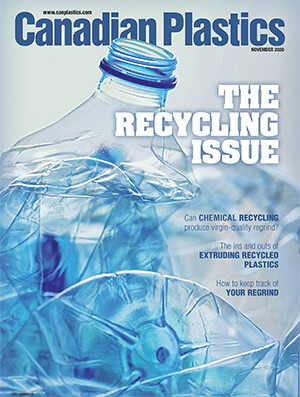
Polymer fibres might hold the key to tissue regeneration (September 26, 2010)
Canadian Plastics
Research & Development Suppliers/People Ergonomics/Muscoloskeletal Injuries Injury, Illness Prevention Plastics: Technology AdvancesUsing polymers to help regrow torn muscles and tendons? Sounds like something out of a late night sci fi fli...
Using polymers to help regrow torn muscles and tendons? Sounds like something out of a late night sci fi flick, or maybe Mary Shelley’s novel “Frankenstein”, right?
Don’t be too sure.
A Canadian researcher is hoping that within 10 years, people will be able to rebuild tissue and speed the healing process through the implantation of biodegradable microscopic polymer fibres directly into in the damaged area.
Dr. Brian Amsden, a chemical engineering professor from Queen’s University, in Kingston, Ont., is currently developing a technique that places cells from a patient’s body on a polymer prosthetic that stimulates cell growth. After the cells had established themselves sufficiently, the prosthetic would be implanted in the patient’s body; the polymer would then biodegrade, leaving behind nothing but the patient’s own healthy tissue.
For Canada’s aging population – not to mention athletes of all ages – the implications could be very big indeed. “Many baby boomers want to remain active as they get older, and this research has the potential to allow people in their 60s and 70s to live healthier lives and enjoy greater mobility,” Amsden said. “And there’s no reason it couldn’t be used to regrow tendons lost to athletic injury.”
CRUCIAL CRIMP PATTERN
As so often happens with potentially big breakthroughs, Amsden’s technique is the result of a happy accident. Four years ago, Amsden was searching for better material to use as “scaffolding” for replacing damaged ligaments in the human knee, in particular the anterior cruciate ligament (ACL), famed as the source of many a career-threatening sports injury. “We were using basic electrospinning, which is a process that employs an electrical charge to draw very fine – typically microscopic – fibres from a liquid,” he said. “We dissolved a caprolactone-lactide copolymer in a solvent, applied the electrospinning process, and wrapped the filament as it emerged around a rapidly rotating mandrel.”
So far, so good. What Amsden didn’t expect, however, was for the polymer fibres to shrink and form a crimp pattern when pulled from the mandrel – a pattern very similar to that found in the naturally occurring collagen in the ligament of the human knee. “We had no idea that the electrospinning technique would result in spontaneous generation of crimp in the fibres,” he admitted. “We realized very quickly, though, that we’d stumbled on a perfect crimping structure to act as a three-dimensional scaffold for seeding and growing collagen on damaged tissue.”
A NEW TWIST ON TISSUE ENGINEERING
Tissue engineering was first proposed in mid-1980s, and the use of polymers to help stimulate the process came about in the early-1990s. It’s new, in other words, but not brand new. Bringing biodegradable polymers into the equation might just be the game-changer. “Ours is the only material currently being used that has similar properties to native ligament,” Amsden said. “The biodegradable polymer is stable enough to act as a scaffold to guide the cells, but not so stable that it won’t dissolve. Eventually, as the cells grow on the material and secrete their own proteins, they’ll break down and replace the underlying polymer. At the end of the process, nothing will remain but the patient’s own tissue.”
Although Amsden spearheaded the project, he hasn’t been working alone. His colleague at Queen’s, Stephen Waldman, an associate professor with the department of mechanical and materials engineering, has collaborated on the research, as have scientists from the University of Western Ontario and the University of Toronto.
And as for any alleged similarities to Frankenstein’s monster? “I don’t see anything Frankenstein-ish about the project, because almost everything involved in it is you,” Amsden said. “The only element that isn’t you is the polymer, which eventually disappears.”
